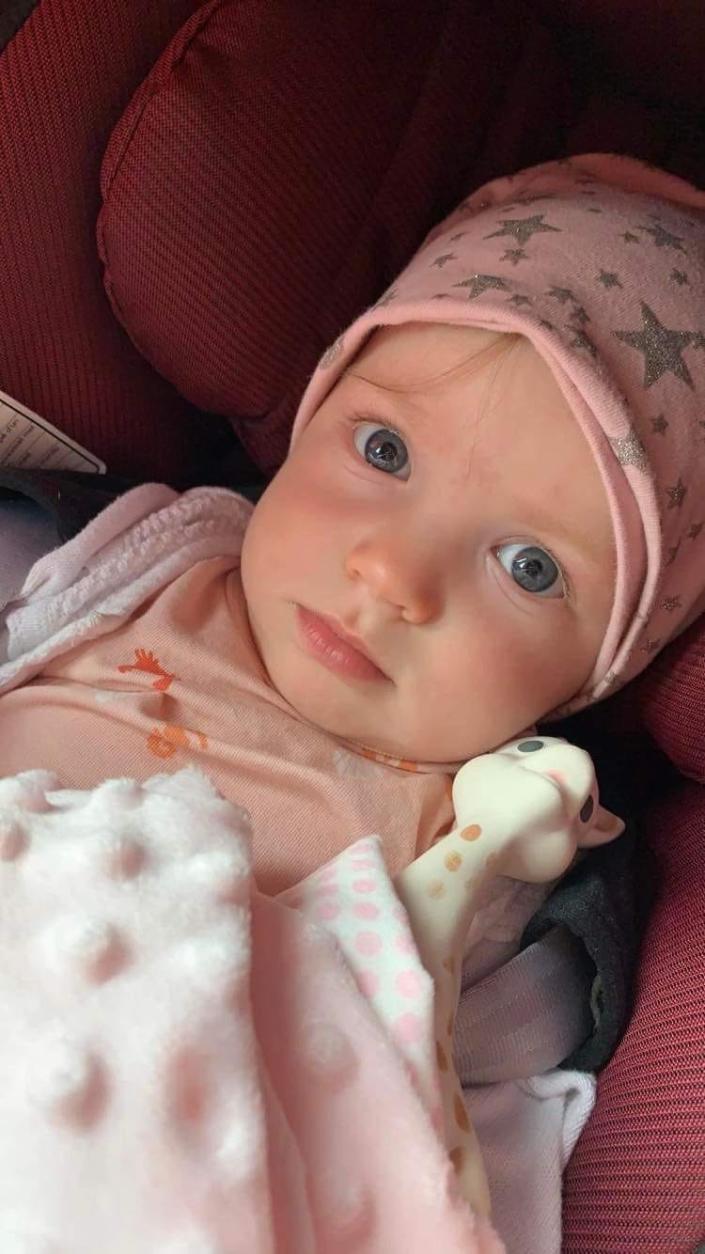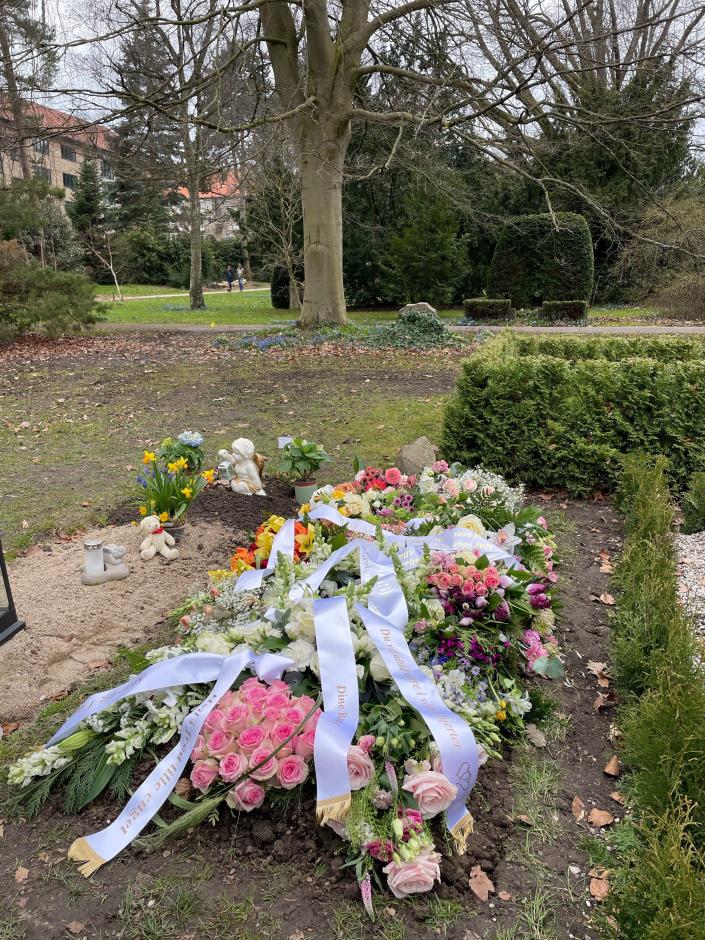New medical treatments, such as gene therapies, have the potential to save lives or transform them completely, to provide hope where there is none and to justify years of scientific research.
Unfortunately, clinical trials for unproven therapies don’t always end well, especially for those who go first.
Alissa Feldborg’s story is one of those.
A trial at the T.H. Chan School of Medicine at the University of Massachusetts offered the little girl and her desperate parents the possibility of reversing her fatal diagnosis.
But on Easter Monday, 28 months after her gene therapy treatment, Alissa, age 3, died.
At one level, it was to be expected. Ever since her parents, Thomas Feldborg and Daria Rokina, received their daughter’s diagnosis of Sandhoff disease when she was 8 months old, they were told to prepare for her death.
Sandhoff, an ultra-rare genetic disease, strikes babies who previously seemed healthy, progressively destroying nerve cells in the brain and spinal cord. The child rapidly deteriorates and usually dies by age 3.
The trial, which USA TODAY wrote about in 2021 as part of a series on rare diseases, offered them a different vision of the future, even though the result wasn’t what they dreamt of.
“We are heartbroken, but also we realize within ourselves that the battle was lost long ago, not now,” Alissa’s father said in a video conversation a week after her funeral. “It’s hard to say, but it was for the best for her in the end.”
See previously: An experimental gene therapy was little Alissa’s only hope. Now, instead of certain death, she faces an uncertain future.
More from this series: From debilitating illness to a ‘normal’ life, new gene therapy treatment promises to transform rare disease
The promise of clinical trials
Feldborg and Rokina, who live in Copenhagen, Denmark, had read about the UMass trial online and were thrilled when Alissa passed all the requirements to be included.
Story continues
The researchers were clear Alissa might not benefit — her disease might already be too advanced, the dosage, based on studies in sheep, might be too low. As the weeks and then months ticked by, waiting for the Food and Drug Administration to approve the treatment, their expectations dimmed.

Still, where there’s action, there’s hope and the couple was grateful to be able to grab onto any sliver.
So, at the end of January 2021, when Alissa wasn’t yet 14 months old, doctors gave her two doses of gene therapy, one infused into her spinal cord and one directly into her brain.
The early days were promising. For about six months, her deterioration slowed. Her smile returned. She seemed almost present.
“There were a lot positive things after this treatment,” Rokina said.
Her ability to swallow and cough also improved, which worried her parents. The couple’s biggest fear was that the therapy, intended to correct the genetic mistake that was poisoning Alissa’s brain, would extend her life, but not substantially improve her vegetative state.
“When we realized it wasn’t going to cure her, we were afraid that it would be a long devastating life for her,” Feldborg said.
How much and how soon?
About 18 months after Alissa’s treatment, the company that sponsored the trial said it could no longer afford to keep it going. UMass Chan raised funds to continue to follow the nine children who had already been dosed.
Dr. Terence Flotte, dean of the medical school, said via email that his team intends to try the therapy on one or two more children, bringing the total to 10 or 11.
Some in the trial were infants and others were older children with later onset disease. The infants show mild improvements and retained neurologic function longer after treatment, Flotte said, while some of the older children experienced a mixed picture with both positive and negative signs.
The gene therapy, which enables the children to make the enzyme they’re missing, also seems to be more consistently effective in a closely related disease called Tay-Sachs.
More from this series: Baby Fitz was born without an immune system. His treatment offers hope for curing rare diseases.
Alissa had been the first patient fully enrolled. Some later children received higher doses and were treated when they were younger.
“They can stop the degeneration, but they cannot heal what is broken,” Feldborg said of the scientists.
The couple’s one regret is that they couldn’t convince the FDA to be less cautious about the therapy. Earlier treatment and a higher dose might have led to a different outcome, Feldborg and Rokina said. They would happily have faced the risk of a brain hemorrhage for the possibility of a better outcome.
“If we could have changed anything, we would have shouted loud enough for FDA to hear us.”
Risk is a necessary part of progress
Medicine advances in fits and starts and relies on volunteers like Alissa’s family, said Dr. Francis Collins, former longtime director of the National Institutes of Health and a lifelong champion of genetic research and therapy.
“I think it’s appropriate to be enormously inspired and excited about the potential” for gene therapy, Collins said.
Roughly 6,500 rare diseases are caused by known DNA misspellings, but treatments exist for fewer than 500 of them so far, he said.
As to why therapies like this don’t always work, Collins pointed to biology.
“People don’t appreciate how complicated human biology is,” said Collins, who has spent his career trying to reverse a genetic disease called progeria that causes rapid aging.
Only one or two spelling mistakes in a person’s 3-billion-letter genome can affect trillions of cells across the body, including in the brain, which is extremely hard to access with treatments, he said.
With gene therapy treatments like the one Alissa tried, “you can see the payoff,” Collins said. “You just can’t see how long it is, how many twists and turns, how many unexpected hailstorms are going to hit you along the way.”
Being among the first patients to receive a gene therapy is challenging for patients and families, UMass’ Flotte said in an emailed statement. “Those pioneering patients and families who choose to go first in such trials demonstrate great courage, as they make sacrifices for the benefit of those who come after them.”
Still, gene therapy holds tremendous promise, Collins said.
“I would want people to be optimistic that over the coming years we’re going to get much better at this — and not to feel hopeless or despondent or pessimistic,” he said.
Choosing hope: Two women, worlds apart, and a rare disease that could offer clues about ALS
Deriving meaning from misery
Over the last six months, Alissa regressed rapidly.
Her seizures returned with a vengeance. Breathing became a struggle. Though doctors had told them she wasn’t aware of her surroundings, her parents worried she was suffering.
They certainly were. Their lives and those of their four older children – three sons from his previous marriage and one from hers – were dictated by Alissa’s round-the-clock care needs. “I would not wish this on my worst enemy,” Feldborg said.
Alissa was resuscitated five times in the last three weeks of her life. The sixth time, it didn’t work.

Now, the boys are each suffering in their own ways and Feldborg and Rokina mostly feel emptiness.
“No emotions, no happiness. The sun is shining, the spring is coming, but you’re just indifferent,” Rokina said.
They have no regrets about participating in the trial even though the outcome didn’t meet their wildest dreams.
Alissa still had a brief blooming after the treatment when she should have seen nothing but decline, Feldborg said.
“What we really hope for now is that there’s some kind of meaning with her life. They’re going on with the trial,” he said. “At some point there will be somewhere it succeeds and this is what we’re hoping for. … If this is the meaning of Alissa’s life, then at least there is some meaning.”
Contact Karen Weintraub at [email protected].
Health and patient safety coverage at USA TODAY is made possible in part by a grant from the Masimo Foundation for Ethics, Innovation and Competition in Healthcare. The Masimo Foundation does not provide editorial input.
More from this series: Decades-long quest to beat Fragile X fueled by persistence, science and relentless optimism
This article originally appeared on USA TODAY: Gene therapy fails for Danish child treated for Sandhoff disease